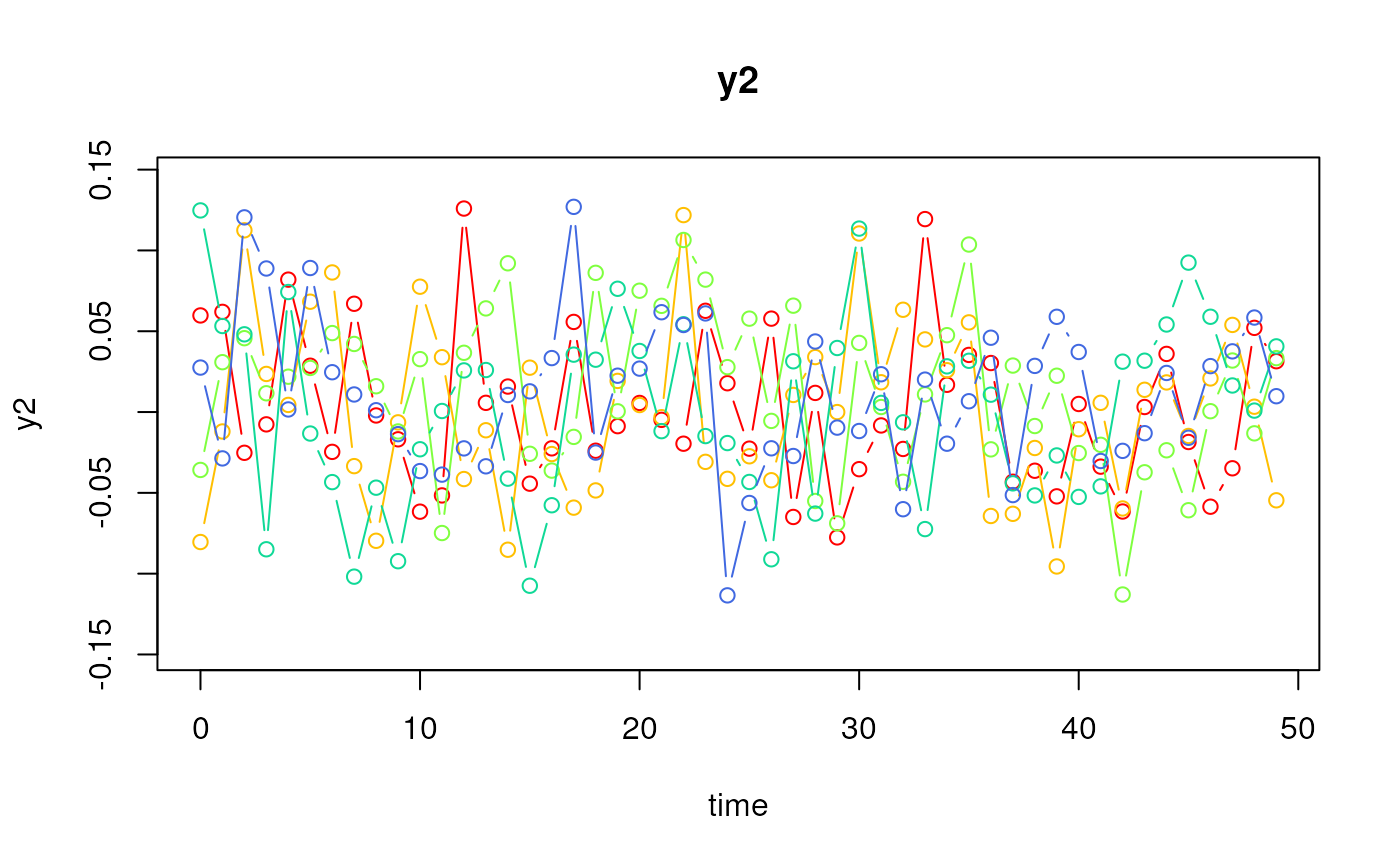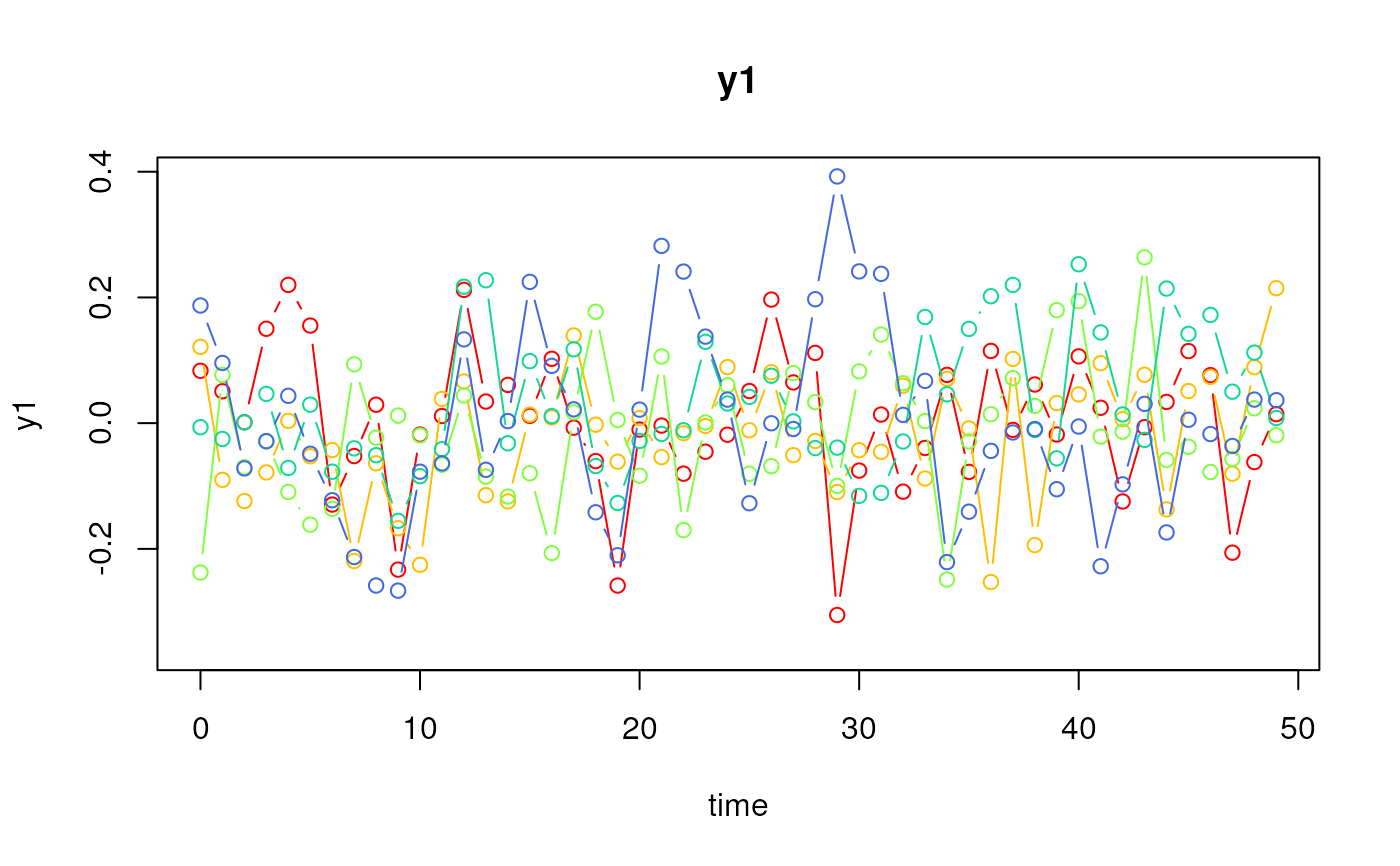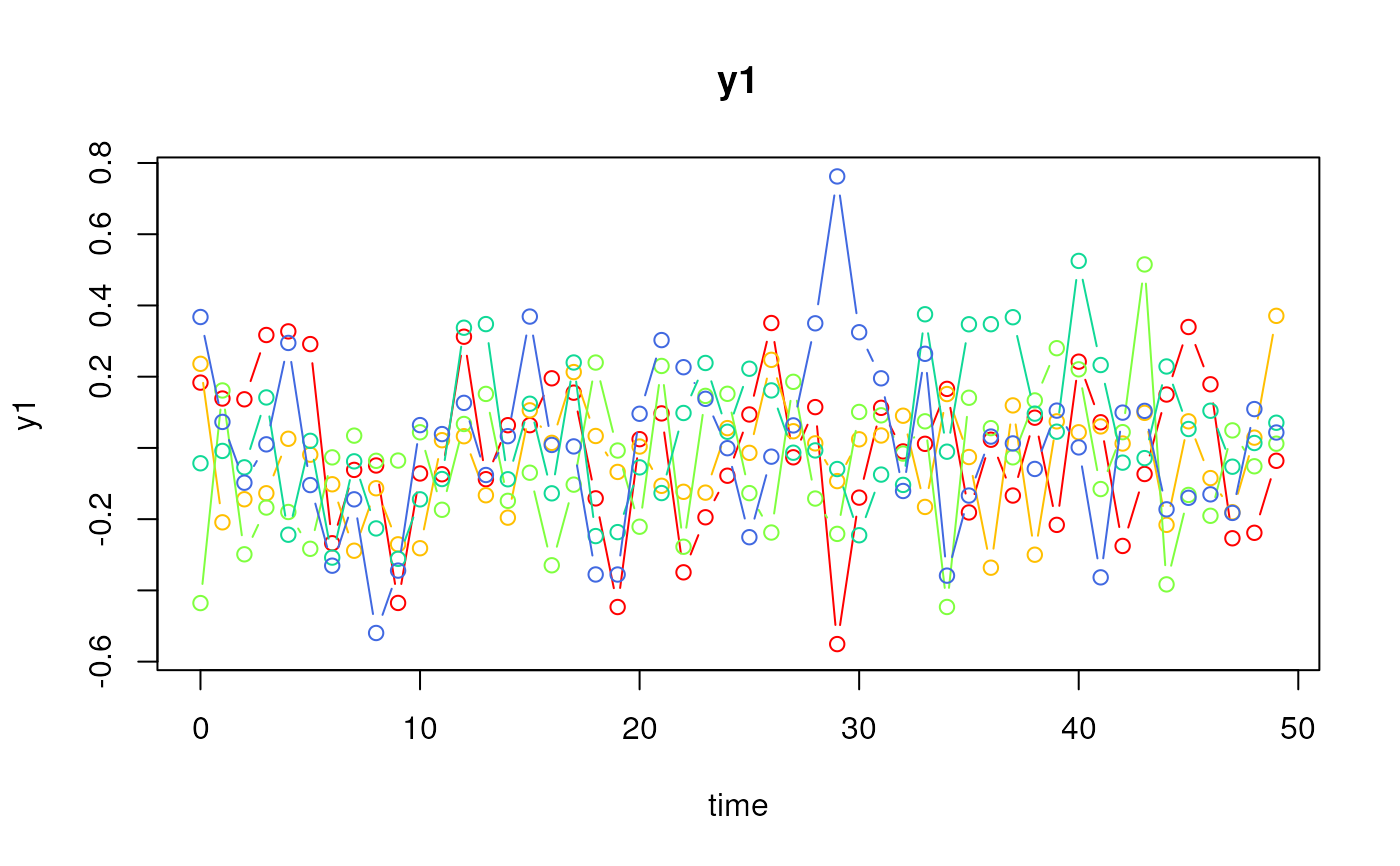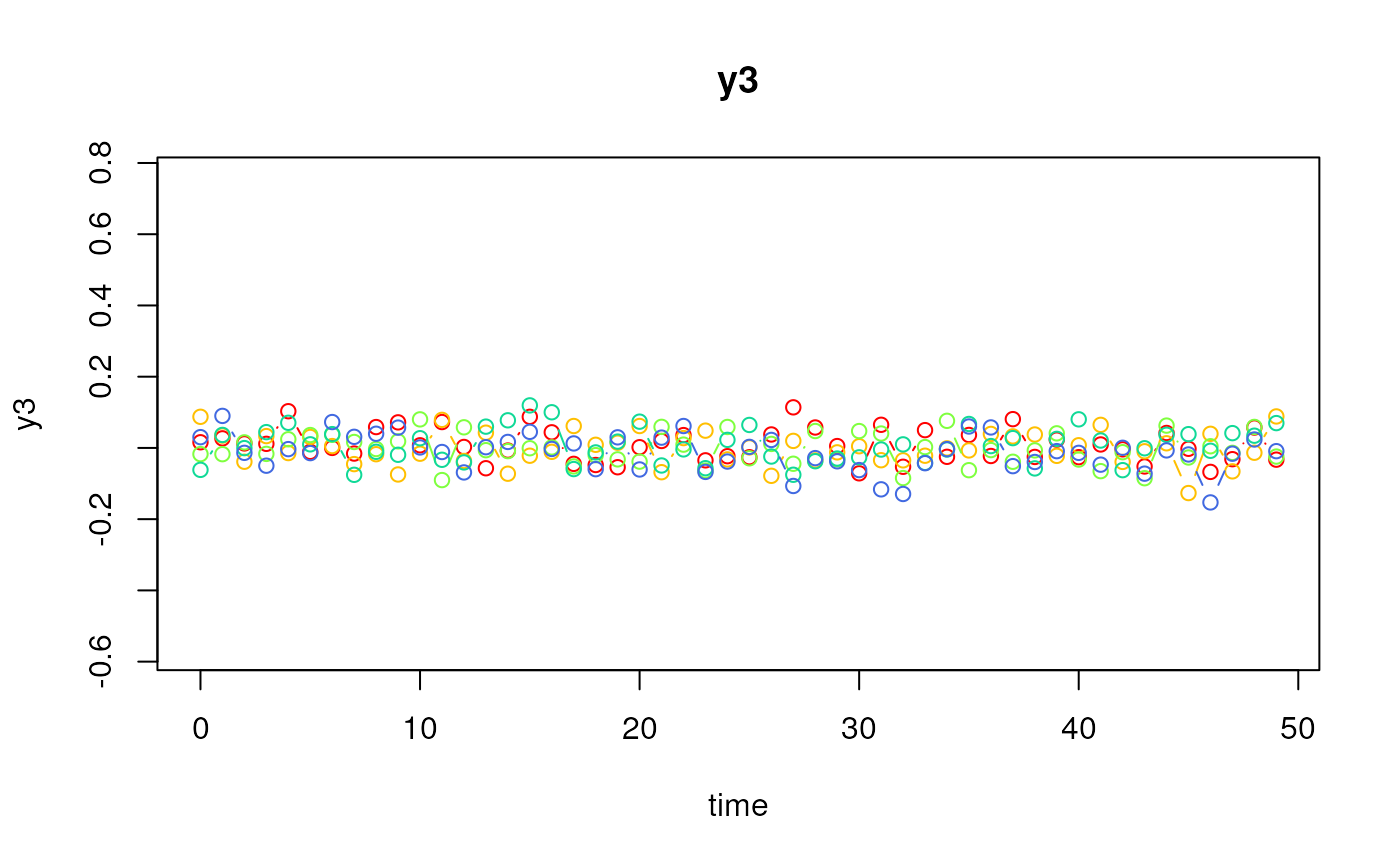Simulate Data from a State Space Model (Individual-Varying Parameters)
Source:R/simStateSpace-sim-ssm-i-vary.R
SimSSMIVary.RdThis function simulates data using a state space model. It assumes that the parameters can vary across individuals.
Usage
SimSSMIVary(
n,
time,
delta_t = 1,
mu0,
sigma0_l,
alpha,
beta,
psi_l,
nu,
lambda,
theta_l,
type = 0,
x = NULL,
gamma = NULL,
kappa = NULL
)Arguments
- n
Positive integer. Number of individuals.
- time
Positive integer. Number of time points.
- delta_t
Numeric. Time interval. The default value is
1.0with an option to use a numeric value for the discretized state space model parameterization of the linear stochastic differential equation model.- mu0
List of numeric vectors. Each element of the list is the mean of initial latent variable values (\(\boldsymbol{\mu}_{\boldsymbol{\eta} \mid 0}\)).
- sigma0_l
List of numeric matrices. Each element of the list is the Cholesky factorization (
t(chol(sigma0))) of the covariance matrix of initial latent variable values (\(\boldsymbol{\Sigma}_{\boldsymbol{\eta} \mid 0}\)).- alpha
List of numeric vectors. Each element of the list is the vector of constant values for the dynamic model (\(\boldsymbol{\alpha}\)).
- beta
List of numeric matrices. Each element of the list is the transition matrix relating the values of the latent variables at the previous to the current time point (\(\boldsymbol{\beta}\)).
- psi_l
List of numeric matrices. Each element of the list is the Cholesky factorization (
t(chol(psi))) of the covariance matrix of the process noise (\(\boldsymbol{\Psi}\)).- nu
List of numeric vectors. Each element of the list is the vector of intercept values for the measurement model (\(\boldsymbol{\nu}\)).
- lambda
List of numeric matrices. Each element of the list is the factor loading matrix linking the latent variables to the observed variables (\(\boldsymbol{\Lambda}\)).
- theta_l
List of numeric matrices. Each element of the list is the Cholesky factorization (
t(chol(theta))) of the covariance matrix of the measurement error (\(\boldsymbol{\Theta}\)).- type
Integer. State space model type. See Details in
SimSSMFixed()for more information.- x
List. Each element of the list is a matrix of covariates for each individual
iinn. The number of columns in each matrix should be equal totime.- gamma
List of numeric matrices. Each element of the list is the matrix linking the covariates to the latent variables at current time point (\(\boldsymbol{\Gamma}\)).
- kappa
List of numeric matrices. Each element of the list is the matrix linking the covariates to the observed variables at current time point (\(\boldsymbol{\kappa}\)).
Value
Returns an object of class simstatespace
which is a list with the following elements:
call: Function call.args: Function arguments.data: Generated data which is a list of lengthn. Each element ofdatais a list with the following elements:id: A vector of ID numbers with lengthl, wherelis the value of the function argumenttime.time: A vector time points of lengthl.y: Albykmatrix of values for the manifest variables.eta: Albypmatrix of values for the latent variables.x: Albyjmatrix of values for the covariates (when covariates are included).
fun: Function used.
Details
Parameters can vary across individuals
by providing a list of parameter values.
If the length of any of the parameters
(mu0,
sigma0_l,
alpha,
beta,
psi_l,
nu,
lambda,
theta_l,
gamma, or
kappa)
is less the n,
the function will cycle through the available values.
References
Chow, S.-M., Ho, M. R., Hamaker, E. L., & Dolan, C. V. (2010). Equivalence and differences between structural equation modeling and state-space modeling techniques. Structural Equation Modeling: A Multidisciplinary Journal, 17(2), 303–332. doi:10.1080/10705511003661553
See also
Other Simulation of State Space Models Data Functions:
LinSDE2SSM(),
LinSDECovEta(),
LinSDECovY(),
LinSDEMeanEta(),
LinSDEMeanY(),
ProjectToHurwitz(),
ProjectToStability(),
SSMCovEta(),
SSMCovY(),
SSMMeanEta(),
SSMMeanY(),
SimAlphaN(),
SimBetaN(),
SimBetaN2(),
SimBetaNCovariate(),
SimCovDiagN(),
SimCovN(),
SimIotaN(),
SimNuN(),
SimPhiN(),
SimPhiN2(),
SimPhiNCovariate(),
SimSSMFixed(),
SimSSMLinGrowth(),
SimSSMLinGrowthIVary(),
SimSSMLinSDEFixed(),
SimSSMLinSDEIVary(),
SimSSMOUFixed(),
SimSSMOUIVary(),
SimSSMVARFixed(),
SimSSMVARIVary(),
SpectralRadius(),
TestPhi(),
TestPhiHurwitz(),
TestStability(),
TestStationarity()
Examples
# prepare parameters
# In this example, beta varies across individuals.
set.seed(42)
## number of individuals
n <- 5
## time points
time <- 50
## dynamic structure
p <- 3
mu0 <- list(
rep(x = 0, times = p)
)
sigma0 <- 0.001 * diag(p)
sigma0_l <- list(
t(chol(sigma0))
)
alpha <- list(
rep(x = 0, times = p)
)
beta <- list(
0.1 * diag(p),
0.2 * diag(p),
0.3 * diag(p),
0.4 * diag(p),
0.5 * diag(p)
)
psi <- 0.001 * diag(p)
psi_l <- list(
t(chol(psi))
)
## measurement model
k <- 3
nu <- list(
rep(x = 0, times = k)
)
lambda <- list(
diag(k)
)
theta <- 0.001 * diag(k)
theta_l <- list(
t(chol(theta))
)
## covariates
j <- 2
x <- lapply(
X = seq_len(n),
FUN = function(i) {
matrix(
data = stats::rnorm(n = time * j),
nrow = j,
ncol = time
)
}
)
gamma <- list(
diag(x = 0.10, nrow = p, ncol = j)
)
kappa <- list(
diag(x = 0.10, nrow = k, ncol = j)
)
# Type 0
ssm <- SimSSMIVary(
n = n,
time = time,
mu0 = mu0,
sigma0_l = sigma0_l,
alpha = alpha,
beta = beta,
psi_l = psi_l,
nu = nu,
lambda = lambda,
theta_l = theta_l,
type = 0
)
plot(ssm)


 # Type 1
ssm <- SimSSMIVary(
n = n,
time = time,
mu0 = mu0,
sigma0_l = sigma0_l,
alpha = alpha,
beta = beta,
psi_l = psi_l,
nu = nu,
lambda = lambda,
theta_l = theta_l,
type = 1,
x = x,
gamma = gamma
)
plot(ssm)
# Type 1
ssm <- SimSSMIVary(
n = n,
time = time,
mu0 = mu0,
sigma0_l = sigma0_l,
alpha = alpha,
beta = beta,
psi_l = psi_l,
nu = nu,
lambda = lambda,
theta_l = theta_l,
type = 1,
x = x,
gamma = gamma
)
plot(ssm)


 # Type 2
ssm <- SimSSMIVary(
n = n,
time = time,
mu0 = mu0,
sigma0_l = sigma0_l,
alpha = alpha,
beta = beta,
psi_l = psi_l,
nu = nu,
lambda = lambda,
theta_l = theta_l,
type = 2,
x = x,
gamma = gamma,
kappa = kappa
)
plot(ssm)
# Type 2
ssm <- SimSSMIVary(
n = n,
time = time,
mu0 = mu0,
sigma0_l = sigma0_l,
alpha = alpha,
beta = beta,
psi_l = psi_l,
nu = nu,
lambda = lambda,
theta_l = theta_l,
type = 2,
x = x,
gamma = gamma,
kappa = kappa
)
plot(ssm)


